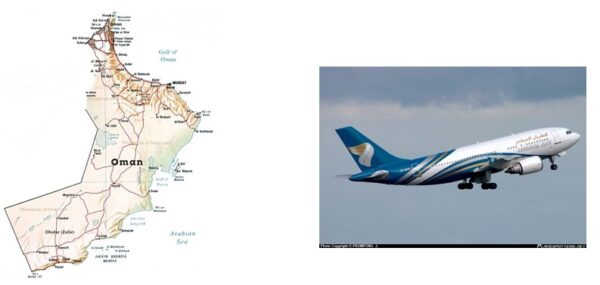Oman Air

Oman is a seafaring Nation and Omanis were famed for their maritime skills in the 9th and 10th centuries. We are all aware of the famous voyage of Sindbad. The seven voyages of Sindbad the sailor describe Oman’s historical seafaring prowess.
However aviation in Oman commenced around the year 1929, when the Airport at Bayt AlFalaj (a dirt track landing strip)was used by P.D.O. (Petroleum Development of Oman), for its aircraft flying between Muscat and their oilfields in the desert.
In the year 1972 O.I.S. (Oman International Services), later changed as Oman Aviation Services in the year 1981, which is now known as Oman Air moved its operations to the new terminal at Seeb International Airport; the official inauguration was on 23rd Dec 1973. Initial facilities were 13 check-in counters, 4 boarding gates, one transfer desk, one arrival carousel and 8 parking bays.
British Airways, Pakistan International Airlines, Air India, Kuwait Airways, Saudia and a few other Airlines commenced operations to Oman. Major developments commenced under the wise leadership of H.M. Sultan Qaboos bin Said. Business was booming and Oman was on its way to achieve modernization not second to any major developed country in the world.
In the year 1977 O.1.S.took over the Gulf Air light aircraft operations division. Gradually the fleet was increased to four F27 aircraft and two Twin Otters to replace Sky Vans. These were ideal for the desert operations as P.D.O. required proper coverage for their oil exploration activities at Fahud, Marmul, Karnalam, Yibul, Lekwar, Mukhaizna,etc.
Operations also commenced to Khasab and Masira Islands which were commercially important to the capital apart from Sur, Buraimi and Salalah, the second largest city in Oman. Widely known as Arabia’s perfume capital, Salalah is a colorful subtropical city famous for its rich history. The need at that juncture was a daily operation.
In the year 1974 Gulf Air was formed by the following Gulf States: Bahrain, Qatar, Oman, and Abu Dhabi on behalf of the U.A.E.Operations commenced with Lockheed Tri-Stars which were registered under Oman.
However after a few years when all the participating States decided to start their own National Carriers, Oman too decided to start its own Airline.
The birth of Oman Air, the National Carrier of Oman, was in the year 1993. Oman Air commenced its operations to the Indian sub-continent and within the Gulf with two leased B737 aircraft from Ansett Airlines.
Seeb International Airport was renamed as Muscat International effective February 2008.
New Regional Airports at Sohar and Duqm were needed for commercial purposes while the Regional Airport at Ras Al Hadd serves the Turtle Beach resort, a major tourist attraction. Apart from Muscat International Airport and Salalah International Airport, there are 20 domestic airports and airstrips in Oman.
The present Oman Air fleet has modern and fuel-efficient aircraft with aesthetically designed interiors. The fleet of 53 aircraft including a Dream liner B787 operates to 50 destinations in the world (2018 statistics). Dawn of a new-year brings changes, and In order to enhance services and optimize revenue, handling section was separated from WY operations this year (2017) and named as Oman Aviation Handling Company An additional Terminal was constructed and opened for operations on the 20th of March 2018.This modern terminal has 86 check-in counters, 19 self service check-in kiosks,29 boarding gates,19 pre-boarding gates,8 arrival carousals,29 contact stands and 30 remote stands, health facilities, food courts, 4 start hotel with 90 beds, swimming pool and spa, car park to hold 8000 cars, entertainment areas, large duty free complex ,food courts and other facilities of a state of the art modern airport.
I was very fortunate to serve Oman and Oman Air for 35 years which is more than half of my life-time. I wish the best to the people of Oman and Oman Air.
D.Ehelepola







